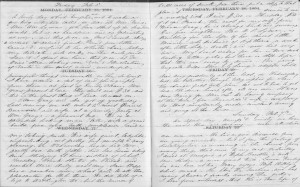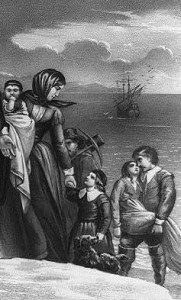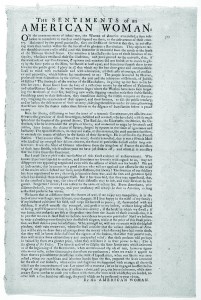 When editing an article for the Mayflower Descendant, I try to look for references the author might have missed, which, in turn, can sometimes lead down a rabbit hole of further information only tangentially related to the article at hand. The following concerns an upcoming article in our Winter Issue by Rich Hall on the Mayflower ancestry of U.S. Senator Tammy Duckworth of Illinois. The article is quite interesting, as it adds an additional generation on Senator Duckworth’s lineage for which she joined the Daughters of the American Revolution.[1] The Senator’s line has a number of generations of people marrying several times, with spouses who were also married several times. The following is one such example. Continue reading Looking for earlier marriages
When editing an article for the Mayflower Descendant, I try to look for references the author might have missed, which, in turn, can sometimes lead down a rabbit hole of further information only tangentially related to the article at hand. The following concerns an upcoming article in our Winter Issue by Rich Hall on the Mayflower ancestry of U.S. Senator Tammy Duckworth of Illinois. The article is quite interesting, as it adds an additional generation on Senator Duckworth’s lineage for which she joined the Daughters of the American Revolution.[1] The Senator’s line has a number of generations of people marrying several times, with spouses who were also married several times. The following is one such example. Continue reading Looking for earlier marriages
Tag Archives: Women’s History Month
Patriarchs and matriarchs

In my last post (in a footnote), I gave a summary of presidents with Mayflower ancestry. Readers called attention to the fact that some of the presidents were grouped by descent from a male passenger, while in some of these groupings the male passenger’s wife was also a passenger. The footnote was meant to be brief, and referred to pages in Ancestors of American Presidents, which had more specific information (including all passengers, female and male, within a family from which each president descended).
While I was not specifically leaving out female passengers (other Mayflower passengers who were themselves children of named passengers were also omitted), the comments clearly spoke to the often “male-preferred” nature of how genealogies are frequently summarized, leaving out or minimizing female ancestors. Continue reading Patriarchs and matriarchs
‘Decidedly frosty’
 Researchers unfamiliar with the history of the New England Historic Genealogical Society may assume women have been members since the organization’s founding in 1845. In fact, for the first fifty years, women were denied membership. In 1894, some members began to propose opening membership to women: “The reaction was haughty and dignified, if not decidedly frosty.” Women quietly persisted in submitting their applications to male members courageous enough to offer women’s names for election. When a woman’s name was read, though, it was greeted by silence. Several men went so far as to argue that “membership was limited to persons,” and women could not join because they were not “persons.” In early 1897 the issue was put to a vote by special ballot and passed, 451 in favor and fifty opposed, with thirteen offering qualified approval. On 2 February 1898, thirty-six women were nominated, twenty-nine accepted membership — and a new chapter began at NEHGS.[1] Continue reading ‘Decidedly frosty’
Researchers unfamiliar with the history of the New England Historic Genealogical Society may assume women have been members since the organization’s founding in 1845. In fact, for the first fifty years, women were denied membership. In 1894, some members began to propose opening membership to women: “The reaction was haughty and dignified, if not decidedly frosty.” Women quietly persisted in submitting their applications to male members courageous enough to offer women’s names for election. When a woman’s name was read, though, it was greeted by silence. Several men went so far as to argue that “membership was limited to persons,” and women could not join because they were not “persons.” In early 1897 the issue was put to a vote by special ballot and passed, 451 in favor and fifty opposed, with thirteen offering qualified approval. On 2 February 1898, thirty-six women were nominated, twenty-nine accepted membership — and a new chapter began at NEHGS.[1] Continue reading ‘Decidedly frosty’
Salient points

One of my great-grandmothers[1] was a penniless orphan, the kind found in storybooks: beautiful and, secretly, a dispossessed member of a once proud family. As often happens when a child’s parents die young, much of this background was lost: my grandmother’s mother, born Sara Theodora Ilsley in Newark, was the daughter of a composer (and member of a distinguished family of musicians), granddaughter of one of the men who owned the yacht America,[2] and the descendant of a notable set of families along the Eastern Seaboard, including the first Congressman from New York City (and an aide-de-camp to General Washington)[3] and the Attorney-General of the Colony of Pennsylvania.[4]
Her descendants knew almost nothing of this when I was growing up, perhaps because of that break occasioned by Theodora’s father’s death in 1887 and her mother’s death in 1895, when she was fourteen. Continue reading Salient points
Revolutionary women

March is women’s history month, which makes me think of my favorite women’s history topic, women in the American Revolution. Specifically, I enjoy learning about the social history of the time. Working as a family history researcher, these themes generally take a back seat to primary source documentation like vital, church, and probate records. But diaries and letters between family and friends remains one of my favorite sources to examine. What was the time period like for women? What were society’s expectations of them and how did they fulfill them? While women still held tight to traditional female roles, the American Revolution provided extraordinary circumstances for women and their daily lives.
The Massachusetts Historical Society holds papers for the Paine family of Taunton, Massachusetts. These family letters and diaries are full of details about life at the time and demonstrate themes of politics, marriage, and wartime separations. Continue reading Revolutionary women
Women in the Gray diary: Part Two

Regina Shober Gray kept a diary for 25 years. Taking a smaller portion of the diary – the period between 1861 and 1870 – and with a focus (for Women’s History Month in March) on some of the women the diarist mentions, I have assembled a few representative entries from those years. (See last week’s post for the 1861–1865 entries.)
Mrs. Gray’s reflections range over marriage for money and position (March 1861), the servant question (June 1862 and October 1867), women in the public sphere (March 1863), her own emotional state (April 1865), a chastening romantic episode (February 1866), the coarsening effects of modern life (February 1868), and a modest attempt to aid poor but proud working women in Boston (January 1870):[1] Continue reading Women in the Gray diary: Part Two
Women in the Gray diary: Part One

Regina Shober Gray kept a diary for 25 years, through the period of the Civil War and Reconstruction, through the deaths of several of her siblings and, in 1880, her husband Dr. Francis Henry Gray. Taking a smaller portion of the diary – the period between 1861 and 1870 – and with a focus (for Women’s History Month in March) on some of the women the diarist mentions, I have assembled a few representative entries from those years.
Mrs. Gray’s reflections range over marriage for money and position (March 1861), the servant question (June 1862 and October 1867), women in the public sphere (March 1863), her own emotional state (April 1865), a chastening romantic episode (February 1866), the coarsening effects of modern life (February 1868), and a modest attempt to aid poor but proud working women in Boston (January 1870): Continue reading Women in the Gray diary: Part One
Many hands, many cradles

I’m in the middle of doing some research for a lecture that I’ll be giving in April at NEHGS entitled “The Hand that Rocked the Cradle.” It will use an informal statistical sampling of the women who have been included in the Early New England Families Study Project so far to see if we can form any general pictures about these ladies and their families. Preliminary statistics are interesting.
The gross totals: 88 women who had 116 husbands, 608 children (an average of about 7 each) and 174 step-children. I think that is what they call “populating a wilderness!”
On average these women were born about 1620, came to New England about 1636 (about age 16), were married for the first time about 1640 (age 20), and lived to about 1682 (age 62). Those who had multiple marriages averaged age 41 for the second marriage (22 women), 46 for the third (4 women), and 42 for the fourth (1 woman).
The youngest at first marriage was 15, oldest at first marriage, 32. The woman who lived to the greatest age was 97, and the one who died the youngest was 21. Continue reading Many hands, many cradles
“Deputy Husbands”

The role of women in America in the seventeenth and eighteenth centuries was not confined simply to matters within their households, as some have popularly believed. Historian Laurel Thatcher Ulrich has come up with the term “deputy husbands” to describe women’s potential role in the colonial household. In some cases, women “shouldered male duties,” Ulrich writes. “These might be of the most menial sort—but they could also expand to include some responsibility for the external affairs of the family.”1 Continue reading “Deputy Husbands”